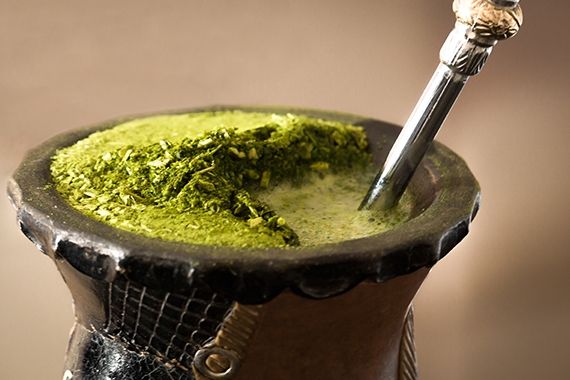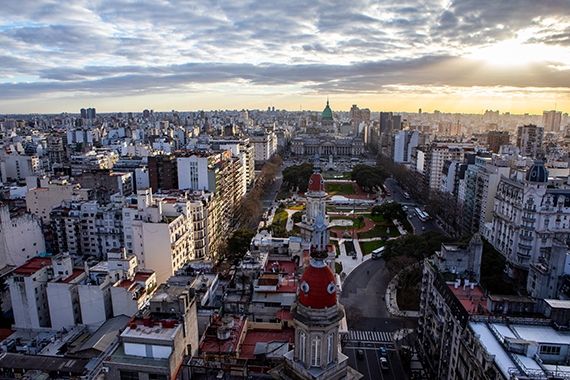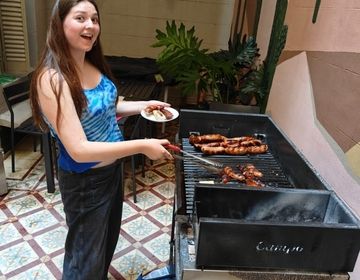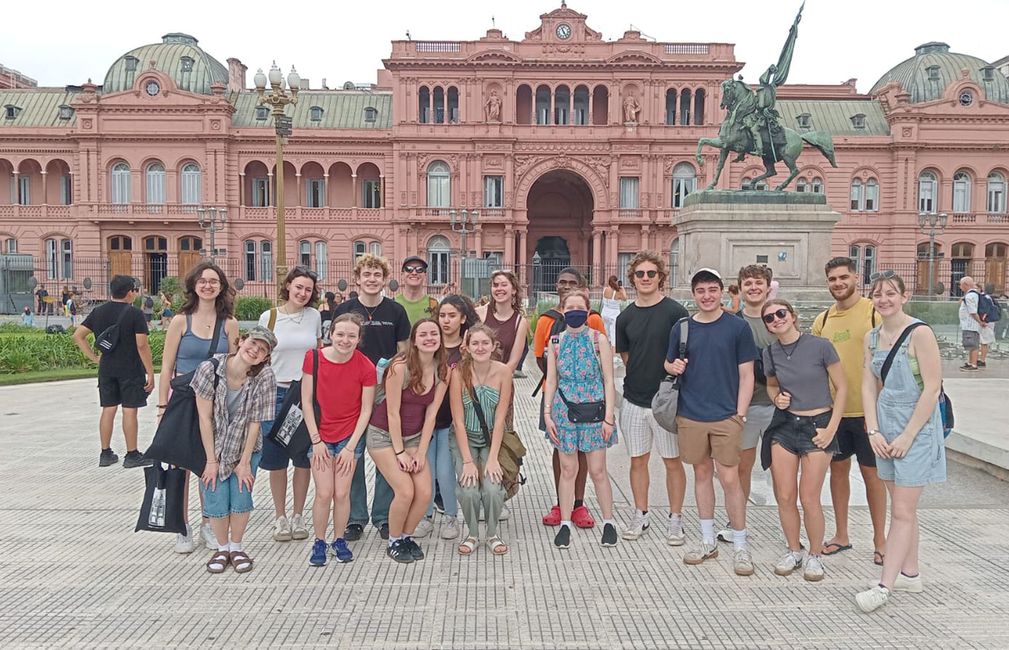EAT, DRINK, EXPLORE: BUENOS AIRES

BEST FOOD TO EAT IN BUENOS AIRES
It’s true, Argentina produces some of the best beef on earth. But given cattle’s impact on our climate, I’d prefer to steer you toward another Argentinian delight: alfajores. Like the macaron in Paris, alfajores are featured in every bakery case in Buenos Aires. Two delicate buttery cookies are joined with a generous swath of dulce de leche, rolled in coconut flakes, and coated in powdered sugar. Dulce de leche is a creamy caramel, delicious enough to eat by the spoonful. Paired with shortbread cookies, coconut, and powdered sugar? Heaven.
Top Cultural Foods To Try in Buenos Aires
Buenos Aires has a variety of regional and traditional foods we highly recommend trying while studying abroad, including:
- Asado: Also known as Argentine BBQ, Asado is well-known for it's cultural significance and unique slow, wood-fire cooking technique that creates tender, juicy and flavorful smoky meat. Plus, it's more than just a meal - it's a social ritual that brings groups together to enjoy Argentine culture!
- Choripán: A staple of Argentine culture, Choripán consists of grilled chorizo sausage served in a crusty roll or baguette and topped with various condiments like chimichurri and salsa criolla.
- Chocotorta: Chocotorta is a classic Argentine dessert made with chocolate cookies or biscuits that are layered with a creamy mixture of dulce de leche and cream cheese. It's a simple no-bake but absolutely delicious treat that is often served at social events or birthday parties.

BEST DRINK IN BUENOS AIRES
While coffee is popular in Argentina, nothing matches the yerba mate tea craze. Dried yerba mate leaves are steeped in a hollowed-out gourd and sipped through a long metal straw called a bombilla. Yerba mate is said to have the health benefits of tea, the caffeine content of coffee, the emotional kick of chocolate, and most of the vitamins and minerals needed by the human body. It’s also known to promote friendship and community because drinking mate can be a group activity. The server, or cebador, prepares the mate then passes it around the circle for everyone to sip. As for the flavor of yerba mate? While it most resembles that of green tea, it can be quite bitter and take some getting used to.
Top Cultural Drinks To Try in Buenos Aires
Here are some of the top traditional drinks to try while you're studying in Buenos Aires:
- Yerba Mate: Yerbe Mate is an important cultural symbol of Argentina. It's so significant that it is regularly drank in over 90% of Argentinian homes. With a unique bold and earthy flavor, it's definitely worth trying at least once!
- Fernet con Coca: Fernet con Coa is a widely popular Argentine cocktail made by mixing bitter amaro liqueur with Coca-Cola over ice. You'll often find locals enjoying this drink at social gatherings or during nights out on the town.
- Clarito: The CLarito is a signature cocktail from Buenos Aires dating all the way back to 1935. It's been continuously perfected over the years, and what better place to try it than it's city of origin?

BEST PLACE TO EXPLORE IN BUENOS AIRES
There are so many reasons to include Palacio Barolo on your list of must-sees in Buenos Aires. First and foremost is the view from the lighthouse at the top, where you can literally see all the way to Uruguay on a clear day. Second, and equally impressive, is the jaw-dropping architecture. The building was created by an Italian immigrant at the turn of the 20th century and based entirely on one of the world’s great works of literature: Dante’s Divine Comedy. Like the poem, the building’s 22 floors are divided into three parts: Hell, Purgatory, and Heaven. Each section is filled with overt architectural flourishes reminiscent of the section and best appreciated with the help of a guide.
Top Cultural Attractions to Visit in Buenos Aires
Here are some of the top cultural attractions to visit while you're studying in Buenos Aires:
- Recoleta Cemetery: Recoleta Cemetery is a famous cemetery located in the Recoleta neighborhood of Buenos Aires, and it is both a popular attraction for tourists as well as a significant historical site for native Argentinians. The cemetery is the final resting place for many of Argentina's most prominent historical figures and is home to a number of exciting urban legends and stories.
- La Boca & El Caminito: La Boca is a popular neighborhood in Buenos Aires that is a hub of art and culture. Within La Boca, you'll find El Caminito, a famous street museum featuring colorful houses, street artists and performers.
- Teatro Colón: Explore the Teatro Colón, a world-renowned opera house that is both a national landmark and a major source of cultural pride in Argentina. Beyond its breathtaking architecture and unique design, it is acclaimed for having some of the finest acoustics in the entire world.
Related Posts

How to Asado: A Beginner’s Guide to Argentina’s Favorite Ritual
This post dives into the heart of the Argentine asado — more than just a barbecue, it’s a social ritual that brings people together around fire, food, and conversation. From the role of the asador and essential cuts of meat to must-have sides like chimichurri and ensalada criolla, readers will get a flavorful introduction to what makes an asado a uniquely Argentine experience. Whether you're a guest or planning to host one, this guide has everything you need to understand and enjoy this beloved tradition.

Top 5 Spanish Study Abroad Programs for the Summer
Summer school hasn’t always sounded the most appealing. But you’re probably thinking about it the old way: Stuck in a boring classroom while wishing you were doing anything else. Think... keep reading

Traveling to Patagonia While Abroad in Buenos Aires
By: Liliana Micera Studying abroad in Buenos Aires has been incredible, but once my classes ended I fled the city for the nature of Argentina’s south. I cannot recommend traveling... keep reading




